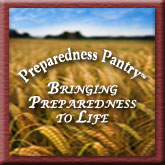Thought I'd share a few tips that work for me:
1. Water down shower gel by about a third. It will be just enough more liquid in consistency that it won't slide off your hands or washcloth. Can't tell how annoying it is to watch that little green blob of gel swirl down the drain!

2. If you have just a few pomegranates, you can juice them using an old-fashined citrus hand press or squeezer. Not the type with the little dome in the center or the tall ones with the slot-machine handle. You still need to do a moderately good job of separating the fruit from the bitter rind. Fill the hopper and squeeze, stir and squeeze again. The clean out the seeds and start again. It is much faster and less tedious than using a sieve or food mill.

3. When I have small amounts of fruit, whether leftovers from the store or late-comers to the garden, I make a version of freezer jam with it so they won't go to waste. It may only be enough for one or two small jars, but it takes little time and usually tastes great. I throw the clean fruit, chopped if larger fruit like peaches or pears, into a saucepan, add some sugar (usually about half of what you'd use in a true canning recipe) and let it simmer. Once things are soft and fragrant, if the fruit has not brokendown some, I'll hit it with the stick blender-- not enough to make a puree, just to make it more spreadable later. Then turn the heat up a little, add the liquid pectin (even if it is only a pint of fruit) and let it come to a boil and simmer for a few minutes more. The pectin is good for you anyway, so why not add it all? When the mixture looks and smells 'jammy,' pour into sterilized jam jars. I use sterilized white Ball lids, not standard canning lids for this, because they will be going into the freezer shortly, not sitting on a shelf. I put the lid on loosely and let them cool on the counter. Be sure to leave a little extra headspace as the jam will expand in the freezer. I let it cool to room temp, then put in the fridge for a few hours, then into the freezer. The gradual cooling helps keep the jar from splitting inthe freezer. After about a day in the freezer, I tighten the lids. Use within a few months and keep in the fridge when thawing and until used up. Use within 2 to 3 weeks of thawing, as it does not have enough sugar to completely retard mold growth over the long term. Because this has less sugar, you can also use as cake filling, on top of a cheesecake, or thin it down for pancake syrup. When blueberries are inexpensive at the grocery store, I put up a few pints this way and it makes great BB preserves.
4. The same Bell lids fit the Classico pasta sauce jars. I clean the Classico jars and use them, with the Bell lids, to store my daily-use amounts of sugar, flour, pasta (we use half a box of dried rotini for a meal) and other dry goods.
Next, bread baking tips!












